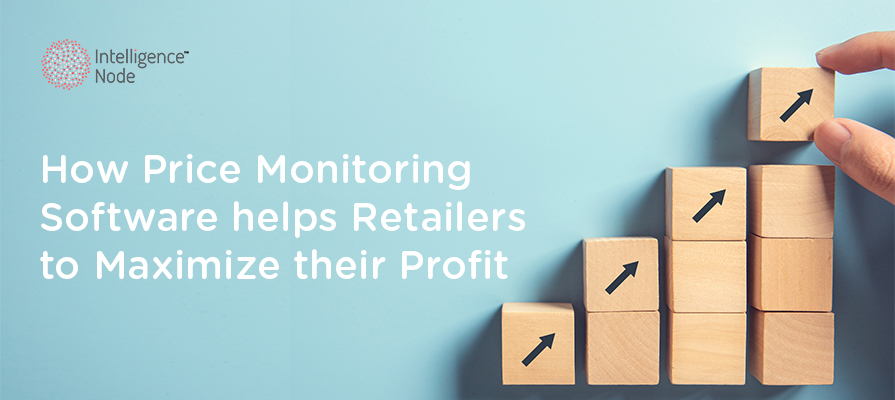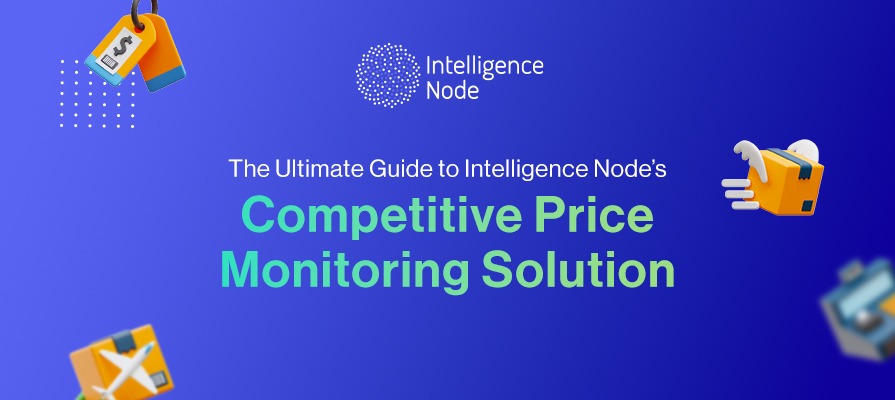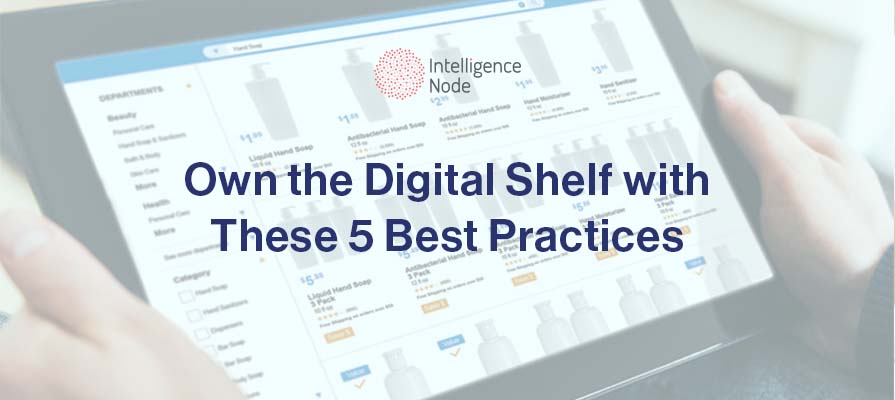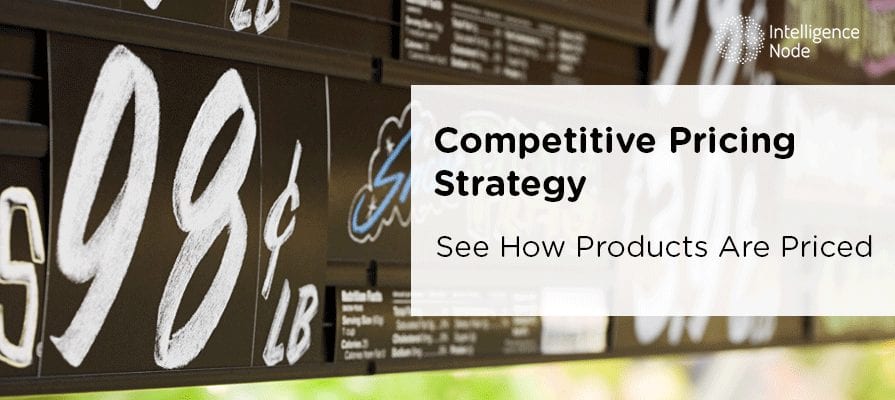Why you need to monitor competitor prices ?
As retailers, brands, or eCommerce business owners, you have to keep an eye on your competition. And one of the most important aspects you need to look out for is ‘pricing’. Customers today have easy access not only to your products but also to your competitor’s products and are known to be comparative shoppers.
Today’s customers have access to search engines and price check apps that allow them to compare prices of the same product across multiple brands, retailers, and websites within seconds. In fact, according to a recent study by Intelligence Node, 94% of customers compare prices while shopping online. Hence, to stay ahead of the competition, retailers need to invest in a smart, competitor price monitoring software that can act as their eyes and ears for price movements across the eCommerce landscape.
The Strategic Advantages of Price Monitoring Software
With an online competitor price monitoring software, you can see when a competitor has lowered or raised a product’s price in real-time. Additionally, you can always be sure that the price information you get is accurate, helping you make decisions backed by 100% accurate data.
Competitor price monitoring also helps you predict future sales and manage your inventory better. For example, if a seller drops the price of a popular item to serve as a loss leader then you know that the sales for that particular item will dip amongst other sellers. With automated price monitoring, you can be better prepared for this situation and make the necessary changes in inventory and ordering immediately.
Keeping a track of all your competitors’ prices across multiple products can be challenging and doing it manually is not going to cut it. This is where ‘competitor price monitoring software’ comes in.
With competitor price monitoring software, you can see when a competitor has lowered or raised a product’s price in real-time. And plus, you can always be sure that the price information you get is accurate so you will always make decisions backed by 100% accurate data.
What is a Price Monitoring Software and How Does it Help You?
Keeping a track of all your competitors’ prices across multiple products at all times is not just challenging but nearly impossible for even a medium-sized online store. This is where ‘retail price monitoring software’ comes in. Price monitoring software is an eCommerce tool to help retailers and brands monitor competitor price movements across the globe. It helps you gain real-time insights into your competitors’ product prices, promotions, stock availability, and other data you can use to optimize your pricing strategy on the go. The real-time online price monitoring also helps you understand at what level your products compete and how your competitors’ pricing-related actions affect your sales.
Features to Look for in a Price Monitoring Software
1. Competitor price monitoring
The most basic feature any competitor price monitoring software should have is to be able to automatically monitor price movements of products across your competitors in real-time and present it to you in a simple, easy to understand dashboard.
2. Stock movement visibility
An ideal price monitoring software should be able to track competitor stock movements, in-stock, out-of-stock products, and product demand. This information can help retailers plan their pricing and promotions strategy . This could be done by increasing prices for products that are out-of-stock at competitor sites, reducing prices of in-demand products, and making the most of competitor stock-outs.
3. Historic pricing data
To plan for product pricing and assortments, it is important to find a pricing solution that can give you a complete historical analysis of product and price movements. By having a complete historical view of your (and if possible, your competitors’) online catalogs, you can track stock movement, and effectively determine the right replenishment points, the ideal product launch timing, and the best prices and promotions.
4. Category standardization and enrichment
A sophisticated price monitoring software should be able to identify identical and similar products with different nomenclature and standardize and enrich descriptions in a pre-decided category tree. This will ensure a methodical and standardized method of identifying and analyzing matching products without missing out on products with varying descriptions. The competitor pricing software should also be able to help you segment product prices based on different categories like the type of product, brands, custom tags, name, etc.
5. In-depth competitor tracking
Apart from pricing monitoring, an important aspect of a smart pricing software is to review competitor products based on other parameters as well like product visibility, customer reviews, product descriptions, bestsellers, etc.
6. Accurate product matching capability
For accurate product and price matching, your price monitoring tool needs to have smart matching capabilities with a high accuracy rate. It should be able to match similar and exact products for both branded and private-label goods. This will ensure your products are accurately matched against similar competitor products for a complete price profile of your competitors.
How Can Retailers Leverage Price Monitoring Software And Maximize Profits
By using an automated price monitoring software, retailers can get a real-time, complete picture of market movements, price updates, and demand trends across their competitor landscape. Based on this information they can then make appropriate changes to their pricing strategy in order to drive more sales and maximize profits.
Let us look at one example. Suppose you are a retailer selling 10,000 SKUs online and want to benchmark against 10 competitors, 7 days a week. This would mean having to make 700,000 pricing decisions per week. With a team of 50 people, working 10 hours a day, for 5 days a week, your team will still have to make 4 decisions/minute, which is nearly impossible to do manually. Price automation makes that possible!
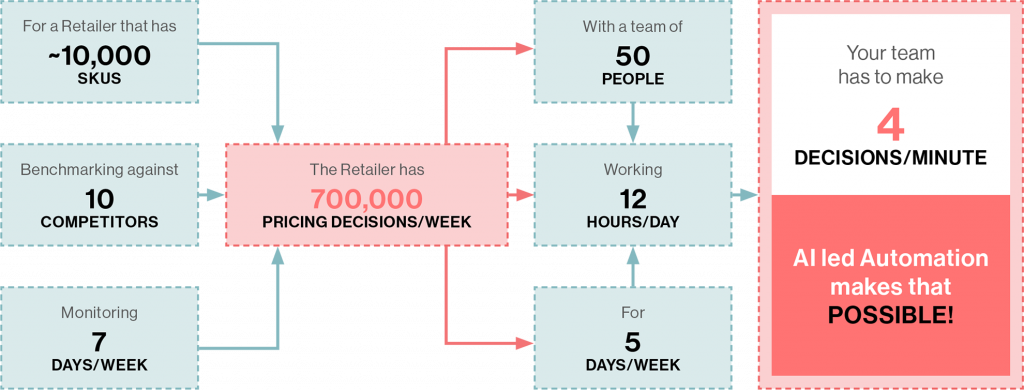
Making use of such an automated online pricing software can ensure the availability of all the information on a single, unified platform. You can view information like competitors’ prices, trending products, offers, promotions, new arrivals, out-of-stock products, etc. all in one place. Infact, sophisticated, AI-driven pricing software also analyzes this data for you and provides smart pricing and promotions recommendations and next steps to make the most of the information at hand. You have the option to automate the entire process and optimize and update prices across your product catalog in real-time, using rule-based dynamic pricing algorithms, to ensure you don’t miss out on any market advantage.
Here are some ways retailers can leverage smart price monitoring tools to increase margins and grow consumer base:
- Monitor competitor price movements across global eCommerce marketplaces or standalone websites.
- Analyze your prices in comparison to competitor prices for similar products in real-time to optimize prices.
- Compare prices for exact and similar matches for branded as well as private label SKUs across your competitor landscape and match prices instantly.
- Take advantage of market movements and competitor stock-outs and increase/decrease prices, review promotions accordingly for maximum margin gains.
- Review, analyze, and audit your pricing approach with actionable, accurate data and make amends as needed.
- Automate your pricing strategy for faster, error-free pricing decisions.
- Leverage historic data to make accurate demand predictions and adjust your assortments and prices to reflect these predictions.
- Convert shoppers into buyers by offering the most competitive prices in real-time.
- Improve your product descriptions for better visibility and hence higher conversions.
- Make strategic decisions based on competitor movements. For eg., if a competitor dips their prices for a particular product, you can hold off selling that particular product until your competitor goes out of stock and then sell it at a higher price.
- Take stock of your competitors’ assortments and new arrivals and update your store merchandise accordingly.
Benefits of Implementing a Price Monitoring Software
While we have discussed why a price monitoring solution is slowly becoming indispensable to modern retail, to further add to the case in point, let us look at certain benefits of having this solution in your artillery.
- Real-time price monitoring and optimization
- Competitive prices across product catalog, always
- Improved conversion rates
- Increased margins and profitability
- Reduced man-hours and increased savings
- Plug-n-play price monitoring APIs for easy ERP integration
- Automated, error-proof competitive insights
- Accurate product and price matching
Final Thoughts
We are in the era of informed, comparative shoppers who have vast information at their fingertips and compare prices before making a purchase decision. With Amazon reviewing the prices of millions of its products every 2 minutes, retailers and brands need to upgrade their pricing game to thrive in this highly competitive eCommerce landscape. Moreover, with your competitors selling similar or identical products across multiple platforms and marketplaces around the globe, it has become absolutely necessary to harness next-gen pricing technology to transform your business and win the new generation of online shoppers.
About the Author :
Intelligence Node is a real-time retail price monitoring platform that empowers retailers and brands to grow profitability and margins using AI and ML data-driven competitive insights.
